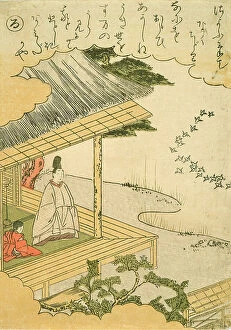Narihira Collection
"Narihira: The Mirror Scene" is a captivating artwork that transports us back to ancient Japan
All Professionally Made to Order for Quick Shipping
"Narihira: The Mirror Scene" is a captivating artwork that transports us back to ancient Japan. Created by Okumura Masanobu in the early 18th century, this piece is part of the renowned series "Famous Scenes. " The fan depicts two distinct sides; on one, we see Narihira and a pilgrim engaged in an intriguing scene. Their expressions are filled with curiosity and wonder as they gaze into a mirror, perhaps reflecting upon their own lives or contemplating deeper truths. On the other side of the fan, delicate chrysanthemums bloom alongside a tranquil brook, symbolizing beauty and serenity. Ariwara Narihira (825-880), a prominent poet from Japan's Heian period, takes center stage in this artwork. His poetic prowess has been celebrated for centuries, making him one of the Thirty-six Immortal Poets depicted by Fujifusa in the 15th century and later immortalized by Hokusai in his Hundred Poems series. Utamaro's portrayal further adds to his legacy. This talented artist captures Narihira's essence with great finesse between 1804 and 1806. Utamaro's attention to detail brings out every nuance of Narihira's character. As we admire these artistic renditions spanning different eras, we can't help but be captivated by Narihira's enigmatic persona. His life remains shrouded in mystery yet continues to inspire artists throughout history. Let us delve into Ariwara no Narihira’s world through these masterpieces—a glimpse into an era where poetry flourished like cherry blossoms under moonlit skies—a time when emotions were expressed through ink strokes rather than spoken words—an invitation to immerse ourselves in the rich tapestry of Japanese culture woven by poets like Narihira himself.
















